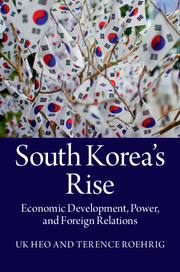Book contents
- Frontmatter
- Dedication
- Contents
- List of figures
- List of tables
- Acknowledgements
- 1 Introduction
- 2 Economic development, state power, and foreign policy
- 3 Inter-Korean relations: confrontation, economic exchanges, and the nuclear crisis
- 4 South Korea and the United States: from dependency to partnership
- 5 South Korea, Russia, and China: from adversaries to economic partners
- 6 South Korea and Japan: an ambivalent relationship
- 7 South Korea and the European Union: evolving cooperation and competition
- 8 South Korea and India: opportunities and obstacles
- 9 South Korea and the developing world: Africa, Latin America, the Middle East, and Southeast Asia
- 10 Contributing to the international community: from consumer to producer
- 11 Conclusion
- Bibliography
- Index
- References
3 - Inter-Korean relations: confrontation, economic exchanges, and the nuclear crisis
Published online by Cambridge University Press: 05 July 2014
- Frontmatter
- Dedication
- Contents
- List of figures
- List of tables
- Acknowledgements
- 1 Introduction
- 2 Economic development, state power, and foreign policy
- 3 Inter-Korean relations: confrontation, economic exchanges, and the nuclear crisis
- 4 South Korea and the United States: from dependency to partnership
- 5 South Korea, Russia, and China: from adversaries to economic partners
- 6 South Korea and Japan: an ambivalent relationship
- 7 South Korea and the European Union: evolving cooperation and competition
- 8 South Korea and India: opportunities and obstacles
- 9 South Korea and the developing world: Africa, Latin America, the Middle East, and Southeast Asia
- 10 Contributing to the international community: from consumer to producer
- 11 Conclusion
- Bibliography
- Index
- References
Summary
Since the division of the country, the relationship between the two Koreas has fluctuated. In general, the inter-Korean relationship can be divided into four different periods based on the characteristics of the relationship: (1) antagonistic period: from the Syngman Rhee administration to the Chun Doo-hwan government, 1948–1987; (2) period of coexistence: the Roh Tae-woo and the Kim Young-sam administrations, 1988–1997; (3) engagement policy period: the Kim Dae-jung and Roh Moo-hyun administrations, 1998–2007; and (4) conditional engagement policy period: the Lee Myung-bak and the Park Geun-hye administrations, 2008 to present.
Four factors have affected South Korea’s policy toward North Korea: economic development, democratization in South Korea, the end of the Cold War, and North Korea’s nuclear weapons program. Among them, South Korea’s economic development played a key role in changing its approach toward North Korea because economic development led to democratization, which gave way to political elite changes and subsequent policy changes. Furthermore, democratically elected leaders implemented their North Korean policy with confidence thanks to political legitimacy and economic superiority. In this chapter, we study the effects of economic development on South Korea’s policy toward North Korea.
- Type
- Chapter
- Information
- South Korea's RiseEconomic Development, Power, and Foreign Relations, pp. 28 - 49Publisher: Cambridge University PressPrint publication year: 2014

